
The Great Seal of the State of Maine was adopted in June 1820. The concept of the design is attributed to Dr. Benjamin Vaughan of Hallowell, Maine, while the original sketch is credited to Bertha Smouse, the step-daughter of Col. Isaac Reed of Waldoboro, Maine, who purportedly wrote its official description and explanation. There have been variations in the details of the seal, but the overall design and images remain true to the original. The center of the seal is a shield adorned with a tranquil scene of a moose resting in a field bordered by water and woods; a pine tree stands tall directly behind the moose. On either side of the shield, a farmer rests on his scythe, and a sailor leans on an anchor. Above the shield is the motto "Dirigo" and a stylized North Star. Below the shield is a banner that reads "Maine". The legislature of 1919 decided that the design of the seal should no longer vary, and the design is still used today.

The Wiscasset Jail and Museum is a historic jail on at 133 Federal Street in Wiscasset, Maine. Built in 1811, it is one Maine's oldest surviving jail buildings, serving as the state's first penitentiary between 1820 and 1824. It is now a museum operate by the Lincoln County Historical Society as the 1811 Lincoln County Museum and Old Jail. It was listed on the National Register of Historic Places in 1970.

The Old Schoolhouse, also known as the York Corner Schoolhouse, is an historic one-room school building on the grounds of the Old York Historical Society at York and Lindsay Streets in York, Maine. Built in 1755, it is one of the oldest surviving schoolhouses in all of New England. It was listed on the National Register of Historic Places in 1973.

The Academy Building is an historic building located on the campus of the University of Southern Maine (USM) in Gorham, Maine, United States. Built in 1806 to house the Gorham Academy, it was listed on the National Register of Historic Places in 1973 for its fine Federal period architecture and its importance in local education.

The Benjamin C. Wilder House is an historic house at 1267 Main Street in Washburn, Maine. Built about 1852, it is a well-preserved example of mid-19th century vernacular architecture in northern Aroostook County, built in the first decade after widespread settlement began of the area. The house was listed on the National Register of Historic Places in 1987. It is now owned by the local Salmon Brook Historical Society and operated as a historic house museum.
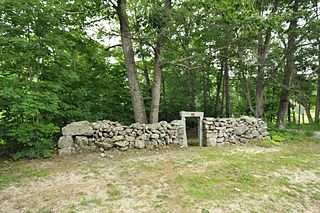
Turner Cattle Pound is a historic animal pound at the corner of Gen. Turner Hill Road and Kennebec Trail in Turner, Maine. Built in 1816, it is a well-preserved example of a once-common feature of New England's agricultural communities. It was listed on the National Register of Historic Places in 2009.
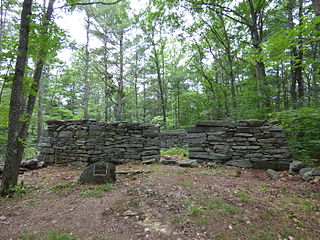
The Farmington Town Pound is an historic animal pound in Farmington, New Hampshire. It is located on the north side of Pound Road near its intersection with Ten Rod Road. Built in 1823, it is one of the best-preserved 19th-century pounds in southeastern New Hampshire, and is now maintained by the Farmington Historical Society. It was listed on the National Register of Historic Places in 1993.
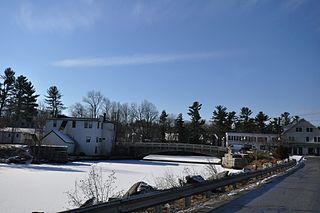
The Goffstown Covered Railroad Bridge was a rare railroad covered bridge in Goffstown, New Hampshire. It was built in 1901 by the Boston and Maine Railroad, on the site of an earlier bridge built in 1850 by the New Hampshire Central Railroad, and carried its tracks across the Piscataquog River in the center of Goffstown. The bridge was listed on the National Register of Historic Places in 1975. It was destroyed by arson in 1976, as would later be the case with the Hillsborough Railroad Bridge in 1985.

The Stone School is a historic school building at 1 Granite Street in Newmarket, New Hampshire. Built in 1841-42, it served the town as a school until 1966, and is a distinctive example of the town's stone architecture. It is now the Stone School Museum, a local history museum. The building was listed on the National Register of Historic Places in 1978.

The Greenwood Cattle Pound is an animal pound located on Greenwood Road, 0.3 miles (0.48 km) east of Maine State Route 219 in Greenwood, Maine. Completed in 1836, the roughly square stone structure is a reminder of the town's agrarian past. It was listed on the National Register of Historic Places in 2007.
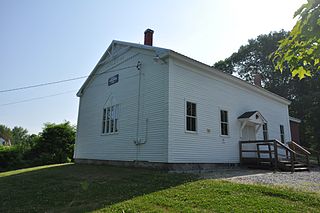
The Lovell Meeting House is a historic meeting house at 1133 Main Street in Lovell, Maine. Built in 1796, it served as Lovell's town hall and as a religious meeting place until 1852, when the Lovell Village Church was built. From then it has served strictly civic functions, and is still the location of Lovell's town meetings and voting. It was listed on the National Register of Historic Places in 2014.
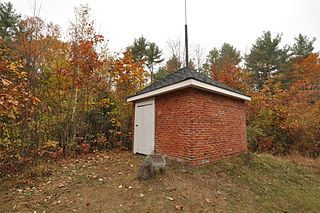
The Buxton Powder House is a historic military storage magazine in Buxton, Maine. Built in 1813, this small brick building housed the community's military supplies during the War of 1812, and is one of three such structures to survive in the state. It is located in a field off Long Plains Road near the center of the town. It was listed on the National Register of Historic Places in 1976.

The Charlotte Pound is a historic animal pound on Charlotte Road in Charlotte, Maine. Built in 1872 out of logs on a stone foundation, it is the only documented wooden pound in the state. It was listed on the National Register of Historic Places in 2005.

The Dixmont Town House is a historic civic and community building at 702 Western Avenue in Dixmont, Maine. Built in 1836, it is one of a few well-preserved early town halls in Maine that served a strictly civic purpose. It was used by the town for its town meetings until 1952, and has been restored to an early 20th-century appearance. It was listed on the National Register of Historic Places in 2014.

The Pownal Cattle Pound is a historic stone animal pound in Bradbury Mountain State Park, Pownal, Maine. Built in 1818, it is one of a modest number of these once-common structures left in the state. It was listed on the National Register of Historic Places in 2004.

The Hutchins House is a historic house at 949 Main Street in Waldoboro, Maine. Built in 1879 for the widow of a successful ship's captain and shipbuilder, it is an elaborately decorated example of Second Empire architecture with Stick style features. It was listed on the National Register of Historic Places in 1982; it presently houses a funeral home.
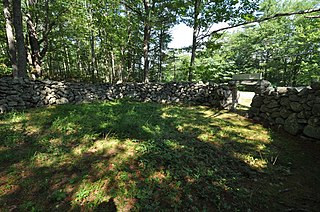
The Jefferson Cattle Pound is a historic animal pound in Jefferson, Maine. Built in 1829, it is one of the state's best-preserved stone pounds. It is located on the south side of Gardiner Road, about 0.75 miles (1.21 km) west of its junction with Maine State Route 213. It was listed on the National Register of Historic Places in 2004.

The Godfrey Ludwig House is a historic house on Maine State Route 32 in Waldoboro, Maine. Built about 1800, it is a well-preserved brick Cape house, built by a descendant of one of the area's early German immigrants. It is notable for features enabling its use as a church. It was listed on the National Register of Historic Places in 1980.

The Hallowell Powder House is a historic military storage facility on High Street in Hallowell, Maine. Built in 1819, it is one of three documented early 19th-century arms magazines in the state. It was listed on the National Register of Historic Places in 2002 as the Powder House Lot.

The Col. Isaac G. Reed House, also known historically as Cutting's Folly, was a historic house at 60 Glidden Street in Waldoboro, Maine. Built in 1807, it was a sophisticated local example of Federal period architecture, with an unusual period bow-shaped room. It was listed on the National Register of Historic Places in 2005. It was destroyed by fire on April 2, 2017, and was subsequently removed from the register.


















